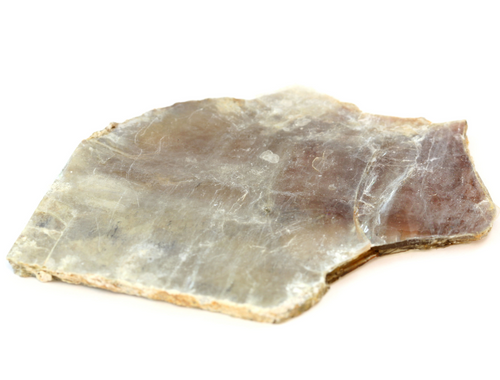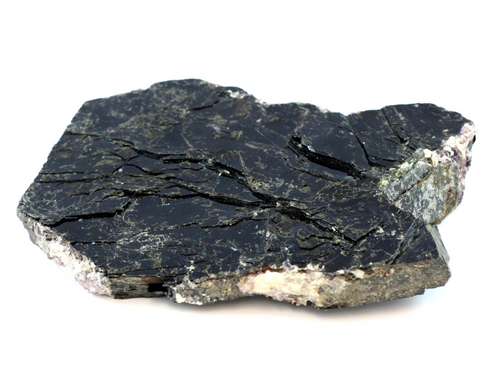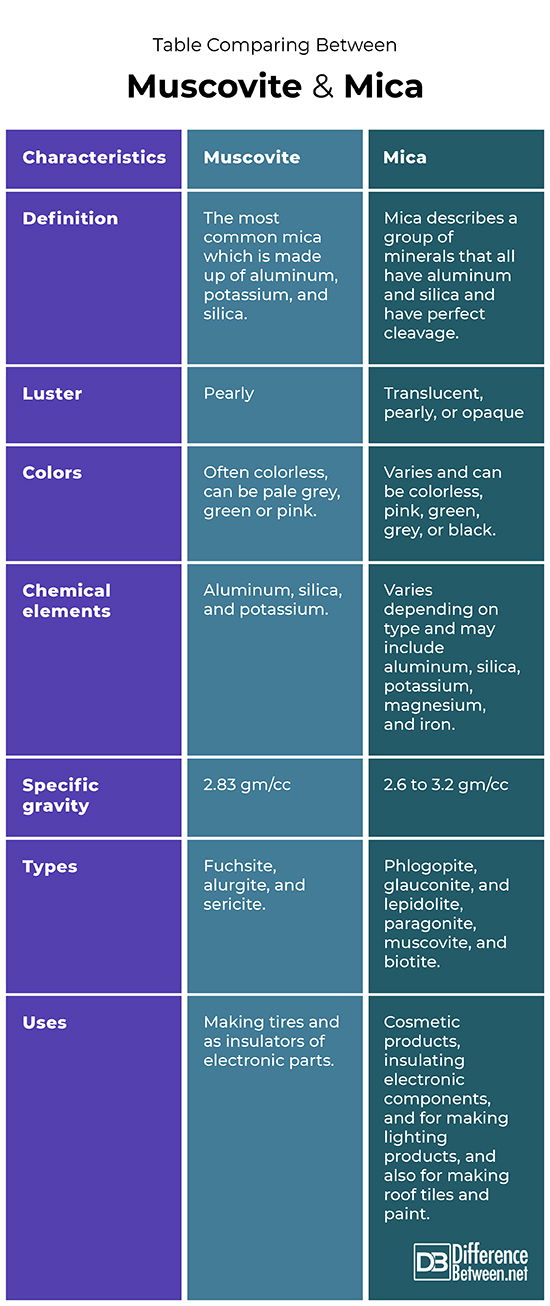Difference Between Muscovite and Mica
Muscovite is one of the kinds of mica that are found in nature. Mica is a group of minerals that occur in sheets and layers and are classed as a phyllosilicate group of minerals.

What is Muscovite ?
Definition:
Muscovite is a type of mica that is made of aluminum, silica, and potassium. It has the following chemical formula: Al2K2O6Si.
Properties:
Muscovite is colorless or it can occur in a pale green or pink color. The luster of muscovite is distinctive and is pearly. Like all other mica minerals, the cleavage of muscovite is perfect. The mineral is also very flat. Little pieces may also flake off of muscovite leading some to refer to this as a flaky type silicate. Muscovite also has the ability to be cut into slices with a knife (i.e., it has sectility). The specific gravity of muscovite is 2.83 gm/cc. The Mohs hardness of muscovite varies from a value of 2.0 to 2.25. This means that the mineral is soft since the Moh’s scale gives increasing hardness from 1 to 10. The refractive index of muscovite is from 1.56-1.60.
Types of muscovite:
Some of the types of muscovite that can be found include fuchsite, alurgite, and sericite.
Uses of muscovite:
The mineral has good insulation properties and, thus, a common use of muscovite is for insulation of electrical parts. Muscovite is also used to make tires.

What is Mica?
Definition:
Mica is one group in a category of minerals called the phyllosilicates that occur in layers.
Properties:
These are hydrous minerals that contain aluminum, silica, potassium and sometimes also magnesium and iron. Cleavage of the mineral is always perfect. Luster varies from opaque to translucent to pearly. These minerals are soft and often occur in sheets. They are insoluble in water and organic solvents. The specific gravity of mica varies from 2.6 to 3.2 gm/cc. The refractive index of the micas, in general, is from 1.56-1.60. The Mohs hardness of mica varies from 2.0 to 2.5.
Types of mica:
There are about 30 different kinds of mica that have been recognized and can be found. However, even though there are many types of mica, only six of these are really the abundant micas. The commonest of all the micas are muscovite and biotite. Other micas include paragonite and phlogopite, glauconite, and lepidolite.
Uses of mica:
There are several uses of mica. Some types of mica are even used to make cosmetic products. Others are used in the lighting industry or as good insulators of electronics components.
Difference between Muscovite and Mica
Definition
Muscovite is the most abundant of all the mica minerals and consists of silica, potassium, and aluminum. Mica is the name given for one group of minerals that always consists of silica and aluminum and has perfect cleavage.
Luster
The luster of muscovite is pearly. The luster of mica varies from pearly, to translucent, or opaque.
Colors
The colors of muscovite can range from colorless to pale grey, green or pink. The colors of mica can range from colorless, to pale colors, to brown or black.
Chemical elements
Aluminum, silica, and potassium are the chief elements of muscovite. The elements of mica vary depending on what type it is and can include aluminum, silica, potassium, magnesium, and iron.
Specific gravity
The specific gravity of muscovite is 2.83 gm/cc. The specific gravity of mica varies from 2.6 to 3.2 gm/cc.
Types
The most common types of muscovite are fuchsite, alurgite, and sericite. The most common types of mica are phlogopite, glauconite, and lepidolite, paragonite, muscovite, and biotite.
Uses
Muscovite is used in the manufacture of tires and it is also used to make insulators of electronic parts. Mica is used to make cosmetic products, lighting products, insulators, and it is used to produce roof tiles.
Table comparing between Muscovite and Mica

Summary of difference between Muscovite and Mica
- Muscovite is a type of mica that is very abundant in nature.
- Mica is a group of phyllosilicate minerals that all have perfect cleavage and contain aluminum and silica.
- Muscovite is very good as an insulator since it does not conduct electricity well.
- There are many uses for mica in industry including making roof tiles and paint.
FAQ
What are the two types of mica?
Muscovite and biotite are the two main types of mica that can be found.
Is mica muscovite metallic?
Mica muscovite is classified as a non-metallic mineral and is a poor conductor of electricity.
What is the distinguishing property between biotite mica and muscovite mica?
The most distinguishing feature is color, with biotite mica being dark brown or black while muscovite mica is colorless to a very pale color.
What is unique about muscovite?
It is a combination of the pearly sheen, colorless to pale color, and perfect cleavage which makes muscovite unique among the minerals in the mica group.
How do you identify muscovite?
You can identify muscovite by its unique properties of color, sheen, and cleavage. These properties allow one to differentiate this type of mica from biotite.
- Difference Between Rumination and Regurgitation - June 13, 2024
- Difference Between Pyelectasis and Hydronephrosis - June 4, 2024
- Difference Between Cellulitis and Erysipelas - June 1, 2024
Search DifferenceBetween.net :
Leave a Response
References :
[0]de Poel, Wester, et al. "Muscovite mica: Flatter than a pancake." Surface Science 619 (2014): 19-24.
[1]Deitrich, R.V. “Mica”. Encyclopedia Britannica, 2022, https://www.britannica.com/science/mica
[2]Luebering, J.E. “”Muscovite”. Encyclopedia Britannica, 2022, https://www.britannica.com/science/muscovite-mineral
